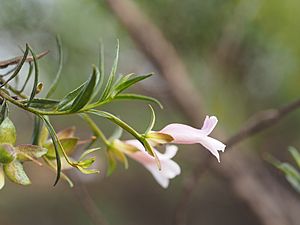Eremophila clarkei facts for kids
Quick facts for kids Turpentine bush |
|
|---|---|
 |
|
| Eremophila clarkei leaves and flowers | |
| Scientific classification | |
| Genus: |
Eremophila (plant)
|
| Species: |
clarkei
|
| Synonyms | |
|
|
The turpentine bush (scientific name: Eremophila clarkei) is a type of flowering plant. It belongs to the figwort family, called Scrophulariaceae. This plant is special because it grows naturally only in certain parts of Australia. You can find it in Western Australia, South Australia, and the Northern Territory.
The turpentine bush is usually a shrub. It has narrow leaves and pretty white or pale pink flowers. It looks quite similar to two other plants: Eremophila georgei and Eremophila granitica.
Contents
What Does the Turpentine Bush Look Like?
The turpentine bush is an upright shrub. It can grow from about 0.6 to 4 meters (2 to 13 feet) tall. Its branches are flat near the ends. They are also very sticky because they have a lot of resin, which is a sticky sap. The branches are smooth, meaning they don't have hairs.
The leaves are dark green and grow far apart on the stems. They are long and narrow, usually about 16 to 45 millimeters (0.6 to 1.8 inches) long. They are also about 3 to 6.5 millimeters (0.1 to 0.3 inches) wide. The edges of the leaves can be smooth, wavy, or even have small teeth.
Turpentine Bush Flowers
The flowers of the turpentine bush grow one by one where the leaves meet the stem. Each flower sits on a flattened, S-shaped stalk. This stalk is about 15 to 27 millimeters (0.6 to 1.1 inches) long.
Each flower has five long, green to purple parts called sepals. These sepals are slightly different in length, usually 10 to 15.5 millimeters (0.4 to 0.6 inches) long. The petals are joined together at the bottom to form a tube. This tube is about 20 to 40 millimeters (0.8 to 1.6 inches) long.
The petal tube can be white, pink, light purple, or purple. The outside of the tube and the petal tips are hairy. But the inside of the petal tips is smooth. The inside of the tube is full of soft, woolly hairs. The lowest petal tip covers the opening of the flower tube.
Turpentine bush flowers bloom from March to October. After flowering, the plant produces dry, woody fruits. These fruits are oval or cone-shaped and about 5.5 to 9 millimeters (0.2 to 0.4 inches) long.
How the Turpentine Bush Got Its Name
The turpentine bush was first officially described in 1859. Two scientists, Augustus Frederick Oldfield and Ferdinand von Mueller, gave it its scientific name, Eremophila clarkei. They published their description in a book called Fragmenta phytographiae Australiae.
The first plant used to describe the species was collected by Oldfield. He found it near the mouth of the Murchison River. The second part of the plant's name, clarkei, honors William Clark. He was a person who helped pay for the trip where the plant was found.
Where the Turpentine Bush Grows
The turpentine bush is common and found in many places. It grows in the Eremaean and South-West plant regions of Western Australia. Here, it likes to grow in sandy or clay soils.
You can also find it in the very southwest part of the Northern Territory. In this area, it is considered "near threatened," meaning it might become endangered. It was first found in South Australia in 1977.
Protecting the Turpentine Bush
The Government of Western Australia's Department of Parks and Wildlife says that Eremophila clarkei is "not threatened." This means it is not currently at risk of disappearing.
Growing Turpentine Bush in Gardens
The turpentine bush is a good plant for gardens. It can handle dry weather and is fairly resistant to frost. It grows best when it is grafted onto other Myoporum plants. It can grow well in many different types of soil. However, it prefers a sunny spot to thrive.
Images for kids
-
E. clarkei growing near Perenjori



